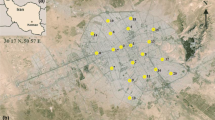Abstract
Human beings could be exposed to lead arising from different environmental sources, such as air, water and soil. Tap water, air and soil samples were collected from four quadrants of Jimma town in southwestern Ethiopia. Eighty samples from each environmental source: water, air and soil samples were collected and analyzed for lead concentration. Prediction of the blood lead level and risk characterization was made using integrated exposure uptake biokinetic model and lead risk was calculated using USEPA guideline. Average concentration of lead in water, air and soils were 24.55 ± 10.01, 1.01 ± 0.41 µg/m3, and 220.08 ± 135.95 µg/g respectively. Uptake of lead by children is significantly higher than the adults. The total risk value was 1.41 for children and 0.37 for adults. The finding revealed that children are more at risk than adults.

Similar content being viewed by others
References
Adela Y, Ambelu A, Tessema DA (2012) Occupational lead exposure among automotive garage workers: a case study for Jimma town, Ethiopia. J Occup Med Toxicol 7:15. doi:10.1186/1745-6673-7-15
Ahmed K, Ayana G, Engidawork E (2008) Lead exposure study among workers in lead acid battery repair units of transport service enterprises, Addis Ababa, Ethiopia: a cross-sectional study. J Occup Med Toxicol 3:30. doi:10.1186/1745-6673-3-30
Alloway BJ (1995) Heavy metals in soils. Blackie Academic & Professional, London
American Public Health Association, American Water Works Association, Water Environment Federation (2005) Standard methods for the examination of water and wastewater. American Public Health Association, Washington, DC
Amitai Y, Brown MJ, Graef JW, Cosgrove E (1991) Residential deleading: effects on the blood lead levels of lead-poisoned children. Pediatrics 88:893–897
ATSDR (2006) HazDat database: ATSDR’s hazardous substance release and health effects database. U.S. Department of Health & Human Services, Atlanta
Bilos C, Colombo JC, Skorupka CN, Rodriguez Presa MJ (2001) Sources, distribution and variability of airborne trace metals in La Plata City area, Argentina. Environ Pollut 111:149–158
Bois FY, Tozer TN, Zeise L, Benet LZ (1989) Application of clearance concepts to the assessment of exposure to lead in drinking water. Am J Public Health 79:827–831
Cañas AI, Cervantes-Amat M, Esteban M et al. (2013) Blood lead levels in a representative sample of the Spanish adult population: The Bioambient. Es Project. Int J Hyg Environ Health. doi:10.1016/j.ijheh.2013.09.001
CSA (2007) 2007 Population and housing sensus of Ethiopia. Ethiopian Central Statistics Authority, Addis Ababa
Davies BE (1980) Applied soil trace elements. Wiley, New York
Griffin S, Goodrum PE, Diamond GL et al (1999) Application of a probabilistic risk assessment methodology to a lead smelter site. Hum Ecol Risk Assess Int J 5:845–868. doi:10.1080/10807039.1999.9657763
Haider T, Haider M, Wruss W et al (2002) Lead in drinking water of Vienna in comparison to other European countries and accordance with recent guidelines. Int J Hyg Environ Health 205:399–403. doi:10.1078/1438-4639-00164
Laidlaw MAS, Mielke HW, Filippelli GM et al (2005) Seasonality and children’s blood lead levels: developing a predictive model using climatic variables and blood lead data from Indianapolis, Indiana, Syracuse, New York, and New Orleans, Louisiana (USA). Environ Health Perspect 113:793–800. doi:10.1289/ehp.7759
Lanphear BP, Winter NL, Apetz L et al (1996) A randomized trial of the effect of dust control on children’s blood lead levels. Pediatrics 98:35–40
Lidsky TI, Schneider JS (2003) Lead neurotoxicity in children: basic mechanisms and clinical correlates. Brain J Neurol 126:5–19
Miller GT (2007) Living in the environment: principles, connections, and solutions, 15th edn. Thomson Brooks/Cole, Belmont, CA
NIOSH (1994) LEAD by Flame AAS. Method 7082, NIOSH Manual of Analytical Methods (NMAM), 4th edn. p 1-7
Nriagu JO, Blankson ML, Ocran K (1996) Childhood lead poisoning in Africa: a growing public health problem. Sci Total Environ 181:93–100
Owen OS (1990) Natural resource conservation: an ecological approach, 5th edn. Macmillan; Collier Macmillan, London
Rebôcho J, Carvalho ML, Marques AF et al (2006) Lead post-mortem intake in human bones of ancient populations by (109)Cd-based X-ray fluorescence and EDXRF. Talanta 70:957–961. doi:10.1016/j.talanta.2006.05.062
Ukhun ME, Nwazota J, Nkwocha FO (1990) Levels of toxic mineral elements in selected foods marketed in Nigeria. Bull Environ Contam Toxicol 44:325–330. doi:10.1007/BF01700154
U.S. Department of Housing and Urban Development (2001) National survey of lead and allergens in housing final report, volume I: analysis of lead hazards, Office of Lead Hazard Control, Washington
USEPA (1989) Risk Assessment Guidance for Superfund. Volume 1, Human Health Evaluation Manual (Part A Baseline Risk Assessment). Office of Emergency and Remedial Response, Washington, EPA/540/1-89/002
USEPA (1991) OSWER Directive 9285.6-03 Human Health Evaluation Manual, Supplemental Guidance: “Standard Default Exposure Factors”, PB91-921314
USEPA (2002) User’s Guide for the Integrated Exposure Biokinetic Model for Lead in Children (IEUBK), Windows(R) Version. Washington, EPA 9285.7–42
USEPA (2005) Supplemental guidance for assessing susceptibility from early-life exposure to carcinogens. Risk Assessment Forum U.S. Environmental Protection Agency, Washington, EPA/630/R-03/003F
USEPA (2007)Lead Human Exposure and Health Risk Assessments for Selected Case Studies (Draft Report). Volume I. Human Exposure and Health Risk Assessments: full-scale, U.S. Environmental Protection Agency, Office of Air Quality Planning and Standards Research Triangle Park, North Carolina, EPA-452/D-07-001a
USEPA (2008) National ambient air quality standards (NAAQS), Environmental protection agency, national ambient air quality standards for lead agency, Washington, EPA-HQ-OAR-2006-0735
WHO (2006) Guidelines for drinking-water quality, 3rd edn. WHO, Geneva
Winther M, Slentø E, Aarhus Univ, National Environmental Research Institute D of PA (2010) Heavy metal emissions for Danish road transport
Acknowledgments
The Authors are most grateful to Jimma University for the financial support.
Author information
Authors and Affiliations
Corresponding author
Rights and permissions
About this article
Cite this article
Getaneh, Z., Mekonen, S. & Ambelu, A. Exposure and Health Risk Assessment of Lead in Communities of Jimma Town, Southwestern Ethiopia. Bull Environ Contam Toxicol 93, 245–250 (2014). https://doi.org/10.1007/s00128-014-1293-7
Received:
Accepted:
Published:
Issue Date:
DOI: https://doi.org/10.1007/s00128-014-1293-7




